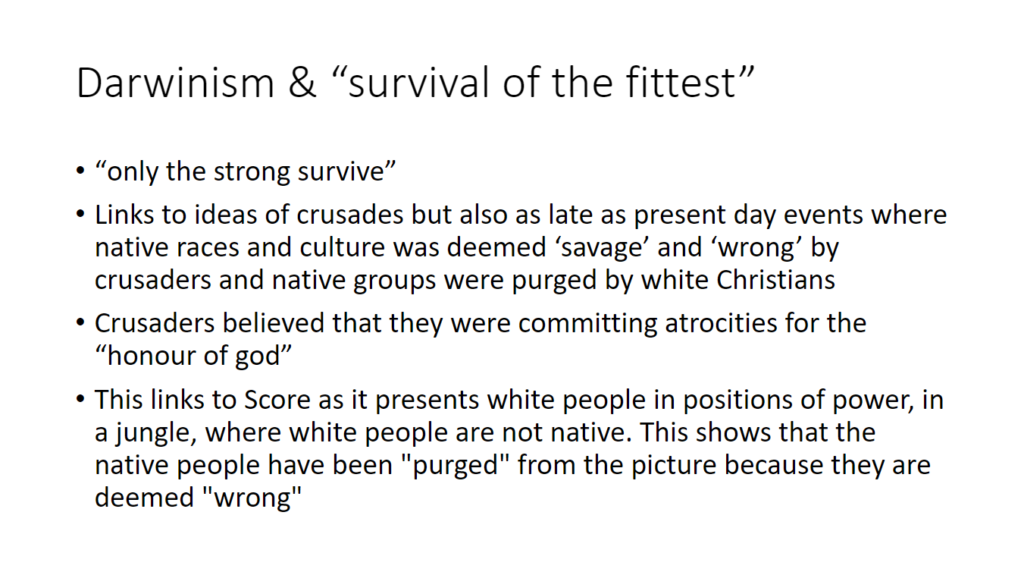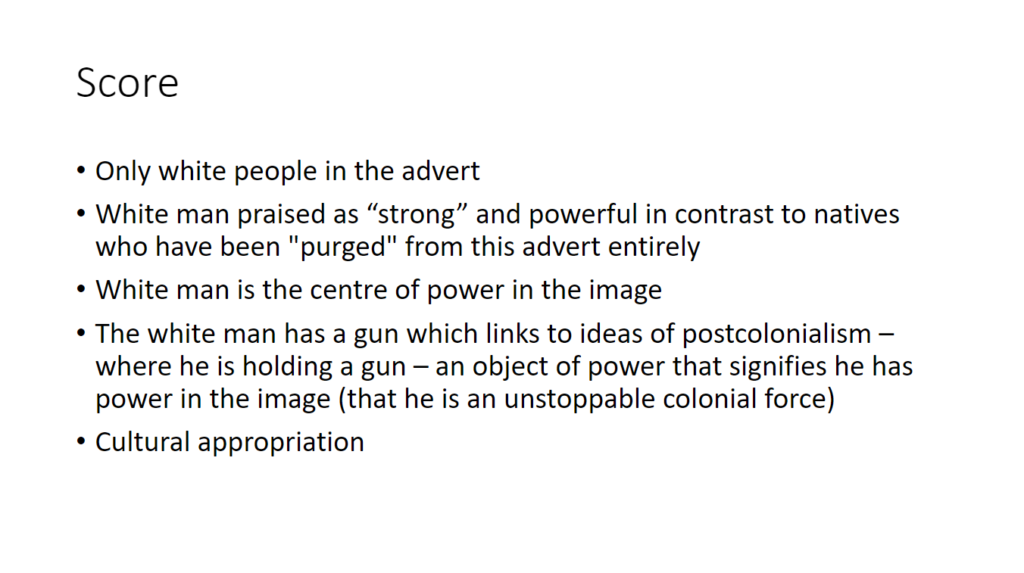
postcolonialism parody 2








Curran and Seaton present the view that a free press relies on a free market where individual newspapers can compete through their political stances and points of view.
Analyse the ways that The i and the Daily Mail attempt to establish a distinctive identity within this free market. To what extent has this been successful? Refer to the specific edition of your case study – for both papers – as well as, on-line versions of these publications.
Curran and Seaton co-wrote a book called “Power Without Responsibility” where the liberal theory of press freedom is discussed. Curran and Seaton describe the liberal theory of press theory within Power Without Responsibility as “ultimately determined by no one but its readers”. This means that the political variety found within the press is not decided solely by its editors – but by its readers. This is shown through newspapers like the i and Daily Mail where they both display a largely differing set of political opinions, with the Daily Mail adopting more centre-right ideologies compared to the i displaying more centrist or centre left ideologies.
The Daily Mail has been known to adopt more dubious strategies to its reporting. The Daily Mail capitalises on the fact that most of its readers will not bother to factcheck articles due to a lot of the more uneducated population reading it, and often creates articles with unreliable information. This is shown on the Wikipedia page for the Daily Mail, where “In February 2017, the Daily Mail became the first source to be deprecated as an “unreliable source” to use as a reference on the English Wikipedia”. The Daily Mail has a centric enough political stance that it can influence central-aligned readers, or those “uninterested” with politics. This is shown through Chomsky’s theory of the Five Filters of Mass Media: ownership, advertising sourcing, flak and anti-communism and fear. The Daily Mail is owned by the Daily Mail and General Trust, which also owns the i. The DMG owns all stages of production, with editing and printing in their own headquarters. Furthermore, both, but particularly the daily mail participate in the advertising stage, where the daily mail includes multiple fashion pages combined with full-page advertisements. certain articles are purged in order to keep readers in the “buying mood”, meaning that despite the newspaper being centre left, the i will never include articles that hold more strong-left political opinions because each newspaper relies on capitalism to survive and a criticism of the system would not put the readers in a “buying mood”. Therefore, it can be said that the Daily Mail is especially successful from this, due to its articles being mainly centre-right (more economically based). The Daily Mail makes particular use of creating its own, unique articles, providing a source that seems to provide strong evidence, with facts and figures. This, as a result, is useful for persuading readers to adopt these political viewpoints. The Daily Mail also incorporates flak, where ideas that threaten its traditional beliefs are shunned. An example of this is an article in the Daily Mail, discussing how “The number of white male, secondary school teachers has fallen by almost 20 percent in a decade, sparking fears over a lack of role models for working class boys”. This provides flack on diversity in teaching and reinforces the idea that the increase in diversity of teachers is bad because “white boys don’t have any role models”. (Conveniently leaving out that minorities never had role models in the first place). This creates racist ramifications as it ultimately creates the idea that “minorities are invading teaching spaces”. This is used to defend the Daily Mail’s centre-right beliefs and pushes its readers to think like this. Finally, the Daily Mail uses anti-communism and fear. While 2020 is the result of a post-red-scare era, anti-communism is still used to reinforce capitalism as the main ideology, with fearmongering used to paint leftism as ‘the evil’. An example of this is a recent article n the Daily Mail. A quarter of the page is headed with read and the communist flag. The title text reads: “Russia’s Cyber War on the Olympics”. However, Russia has nothing to do with communism as the soviet union dissolved in 1992. Furthermore, Russia has become more and more neo-liberal as it has incorporated more and more forms of privatisation. The article frames Russia’s attempt to “sabotage the games” as not Russia’s attempt to sabotage the games, but communism’s attempt to sabotage the games. This reinforces the idea that leftist ideas such as socialism and communism are “evil”, and are “a threat”. This political stance has been incredibly successful for the Daily Mail, as it is currently the top selling newspaper in the UK.
The i has adopted a centre-let political stance, but despite seeming somewhat different to the Daily Mail, they are both owned by the same conglomerate: the Daily Mail General Trust. A notable article in the i is a politics article titled “Even a win is not good news for Democrats”. Further in the article, it questions socialists if socialism is “just an idea” and “would never become a reality”: “The uncomfortable closeness of the election will empower the socialists in his party to push a niggling counterfactual: what if it had been an ideologue, not an establishment-type, at the top of the ticket?”. While the i appears centre-left, it can be argued that both of its opinions of leftism, especially far leftism, are the same, with the i expressing ideas of socialism as “unrealistic” and the Daily Mail expressing stronger ideas of counter-leftism. It can be argued that, historically, the public sphere was a lot more diverse, with a lot of early post-world-war two newspapers taking a leftist, anti-capitalist approach, being allowed to criticise the capitalist system. This was changed after these local newspapers either died out from a lack of funding or were pushed to become more right-wing as they required funding through advertising, which would require complying with the capitalist system. This has meant that the public sphere as a whole since then has shifted more and more to the right, with right wing views beginning to dominate the public consciousness, and as a result, has changed the public sphere to care less about socialist ideas and more about economy-based ideas. The point being, newspaper identities have shifted closer and closer together, to the point where it is a lot harder to tell the difference between centre-right and centre-left.
In conclusion, it can be argued that the identities the Daily Mail and the i have created are not as distinctive as they seem. The Daily Mail General Trust owns not only both newspapers, but all forms of journalism and production. The transformation of the public sphere has caused a large shift towards the political right, which is shown where The Daily Mail is the most popular newspaper in the UK, compared to the i, which is 7th. Furthermore, the i itself has started to shift more to the right, complying with the dominant ideology more and more
lasswell’s model: the daily mail article
WHO:
Sarah Harris and joshua fullard
SAYS WHAT:
“The number of white male, secondary school teachers has fallen by almost 20 percent in a decade, sparking fears over a lack of role models for working class boys”
CHANNEL:
The daily mail newspaper
TO WHOM:
right-wing aligned or centre-right aligned audience
WITH WHAT EFFECT:
reinforces the idea that the increase in diversity of teachers is bad because “white boys don’t have any role models”. (Conveniently leaving out that minorities never had role models in the first place). This creates racist ramifications as it ultimately creates the idea that “minorities are invading teaching spaces”
adjusting voting behaviour in a digital age
b.f. skinner – operant conditioning:
harold lasswell
Zuboff
cambridge analytica
audience theory

lasswell’s model: the daily mail article
WHO:
Sarah Harris and
SAYS WHAT:
“The number of white male, secondary school teachers has fallen by almost 20 percent in a decade, sparking fears over a lack of role models for working class boys”
CHANNEL:
The daily mail newspaper
TO WHOM:
right-wing aligned or centre-right aligned audience
WITH WHAT EFFECT:
reinforces the idea that the increase in diversity of teachers is bad because “white boys don’t have any role models”. (Conveniently leaving out that minorities never had role models in the first place). This creates racist ramifications as it ultimately creates the idea that “minorities are invading teaching spaces”
KATZ, GUREVITCH & HAAS
Personal needs: understanding self (reinforcing ideology)
Social needs: “knowledge” about the world
self confidence, stability, self esteem: if ideas are reinforced that align with the reader’s interests, they may agree giving a sense of stability


gerbner 1975: cultivation theory
Noam chomsky
althusser
stuart hall: theory of preferred reading (1980s)
clay shirky 2000: the end of audience
the idea of “surveillance capitalism”
| Theory | Theorist | Daily Mail | the i |
| Manufacturing consent | Noam Chomsky | The daily mail has been known to create news articles that are controversial and unreliable. The daily mail usually has at least one article that lies on the fringe of controversy, but throughout their article creates evidence to support their views. If readers can empathise with this small article, it may open up the possibility of accepting worse and more controversial articles. The Daily Mail has a more ‘gossip’ feel to it, and is not politically centrist on its opinions. This means that the Daily Mail is more likely to follow the Propaganda model. For example, the daily mail is more likely to participate in flak and anti-communism. | The i and the daily mail are owned by the same corporation, which means that the i can, if willing, can slowly push more right wing content into its newspapers. This means that the passive reader is more likely to slowly, over time, accept this and their agenda change. |
| the Public Sphere | Habermas | ‘The Public Sphere’ refers to any public place of discussion of ideology | |
| Question | Daily Mail | the i |
| When first introduced | 4 may 1896 | 19 october 2010 |
| part of a bigger organisational structure? | Daily mail and general trust | Daily mail and general trust |
| Political compass? | center-right | center-left |
| What kind of journalism do they produce? What is their USP? What stories do they specialise in? | shock based stories and scandals | stories presented in a more factual way but still draw attention |
| What kind of people run the paper? Produce the stories? | The daily mail has always had an imperialist perspective, as well as historically supporting fascism | Presented as liberal democrats but in reality the same people as the Daily Mail |
| Do they have a similar readership reach? | More reach | Less Reach |
| Do they have a similar readership profile / target audience? | average age is 58 | aimed at all ages |
| How are they currently doing? Increasing or decreasing sales and revenue? | head of the newspaper markets, with a massive increase in readers in 2020 | 9th most popular in uk |
| How are they looking to embrace new media technologies? | has a website now | more accessed online |
| Do they have a similar layout and design? | larger broadsheet with more room for articles | smaller and more compact |

In summary, the Daily Mail is an openly Tory newspaper, and is a repeat offender of racist, homophobic and sexist attacks. It historically supported the Nazi party. After WWII, it stopped supporting the Nazi party, but still holds right-wing views and refuses to apologises on its offensive comments.
Fuchs